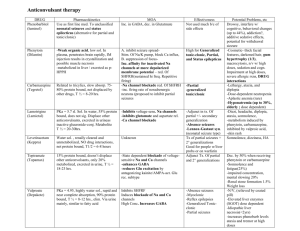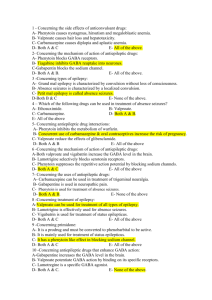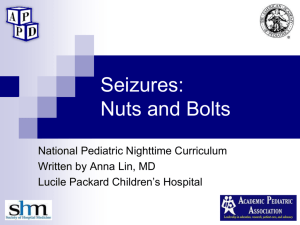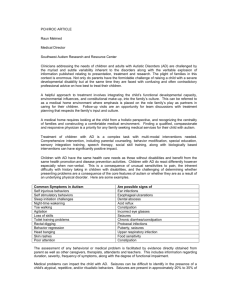Antiepileptic Drugs
advertisement
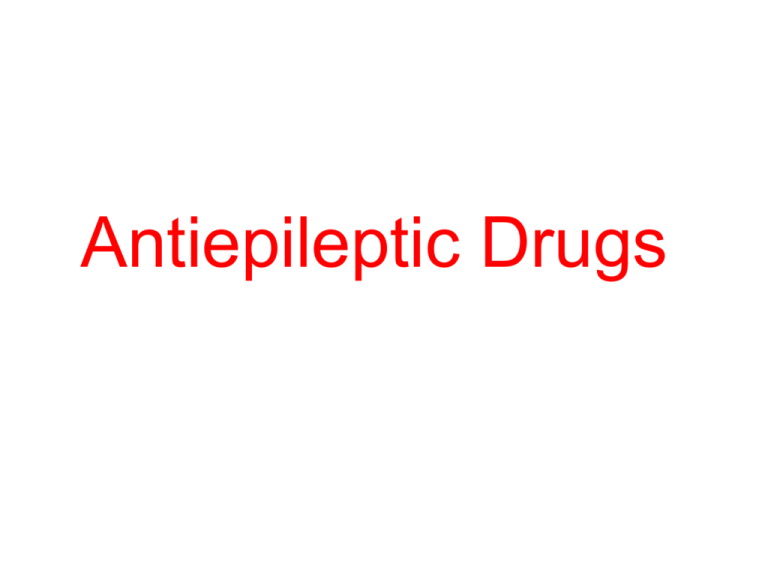
Antiepileptic Drugs Treatment • Try to find a cause. (e.g. fever, head trauma, drug abuse) – Recurrent seizures that cannot be attributed to any cause are seen in patients with epilepsy. • Therapy is aimed at control – drugs do not cure. • The type of seizure determines the choice of drug! • More than 80% of patients with epilepsy can have their seizures controlled with medications. Treatment • Monotherapy with anticonvulsant – Increase dose gradually until seizures are controlled or adverse effects become unacceptable. – Multiple-drug therapy may be required. • Achieve steady-state kinetics • Monitor plasma drug levels • Avoid sudden withdrawal Pharmacokinetics • Most classical antiepileptic drugs exhibit similar pharmacokinetic properties. • Good absorption. • Low plasma protein binding (except for phenytoin, BDZs, valproate, and tiagabine). • Conversion to active metabolites (carbamazepine, primidone, fosphenytoin). • Cleared by the liver but with low extraction ratios. • Distributed in total body water. • Plasma clearance is slow. • At high concentrations phenytoin exhibits zero order kinetics. Therapeutic Range Notable adverse effects of antiseizure medications. Treatment of Seizures Strategies: • Modification of ion conductances. • Increase inhibitory (GABAergic) transmission. • Decrease excitatory (glutamatergic) activity. Drug treatment of seizures • Life-long treatment may be necessary. • It may take weeks to establish adequate drug plasma levels and to determine the adequacy of therapeutic improvement. • Lack of compliance is responsible for many treatment failures. Classification of epilepsies and drug selection. 1. Partial seizures 1. Carbamazepine, phenytoin 2. Valproic acid, lamotrigine, gabapentin, benzodiazepines, barbiturates 3. Adjunct: Tiagabine, topiramate, levetiracetam, zonisamide 2. Generalized seizures: A. Tonic-clonic (grand mal): 1. Carbamazepine, phenytoin 2. Valproic acid, lamotrigine, gabapentin, benzodiazepines, barbiturates 3. Adjunct: Topiramate, zonisamide B. Absence (petit mal): 1. Ethosuximide 2. Valproic acid (when absence seizures coexist with tonic-clonic seizures) 3. Clonazepam 4. Adjunct: Lamotrigine, benzodiazepines C. Myoclonic syndromes: 1. Valproic acid 2. Clonazepam and other benzodiazepines 3. Adjunct: levetiracetam 3. Status epilepticus: • Treatment is intravenous diazepam or lorazepam followed by intravenous fosphenytoin (or phenytoin) or phenobarbital. Mechanisms of Action • 3 main categories of therapeutics: 1. Inhibition of voltage-gated Na+ channels to slow neuron firing. 2. Enhancement of the inhibitory effects of the neurotransmitter GABA. 3. Inhibition of calcium channels. I. Na+ Channel Inhibitors blocks voltage-gated sodium channels by selectively binding to the channel in the inactive state and slowing its rate of recovery Na+ Channel Inhibitors • • • • • • • • Phenytoin (Dilantin, Phenytek) Fosphenytoin (Cerebyx) Carbamzepine (Tegretol, Carbatrol) Oxcarbazepine (Trileptal) Valproic Acid (Valproate; Depakene, Depakote) Lamotrigine (Lamictal) Topiramate (Topamax) Zonisamide (Zonegran) Na+ Channel Inhibitors 1. Phenytoin (Dilantin, Phenytek): • Oldest nonsedative antiepileptic drug. – Indications: • First choice for partial and generalized tonic-clonic seizures • Some efficacy in clonic, myoclonic, atonic, • No effect on infantile spasms or absence seizures – Drug Interactions: • Decreases blood levels of many medications • Increases blood levels of phenobarbital & warfarin Na+ Channel Inhibitors Phenytoin (Dilantin, Phenytek): – Adverse Effects: • • • • Hirsutism & coarsening of facial features Acne Gingival hyperplasia (20-40%) Decreased serum concentrations of folic acid, thyroxine, and vitamin K with long-term use. • “Fetal hydantoin syndrome”: • includes growth retardation, microencephaly, and craniofacial abnormalities (e.g., cleft palate) and is possibly due to an epoxide metabolite of phenytoin. Phenytoin Induced Gingival Hyperplasia 17 year old boy treated with 300mg/day phenytoin for 2 years (unsupervised) Partial recovery at 3 months after discontinuation • Fosphenytoin is a prodrug • rapidly converted to phenytoin in the blood, providing high levels of phenytoin within minutes. • Fosphenytoin may also be administered intramuscularly (IM). • Phenytoin sodium should never be given IM because it can cause tissue damage and necrosis. • Fosphenytoin is the drug of choice and standard of care for IV and IM administration. • Due to sound-alike and look-alike names, there is a risk for medication error to occur. – The trade name of fosphenytoin is Cerebyx® – Celebrex®, the cyclooxygenase-2 inhibitor – Celexa®, the antidepressant. Na+ Channel Inhibitors 2. Carbamzepine (Tegretol, Carbatrol): • Tricyclic, antidepressant (bipolar) – Indications: • First choice for complex partial and generalized tonic-clonic seizures. – Contraindications: • May exacerbate absence or myoclonic seizures. • Blood disorders • Liver disorders Na+ Channel Inhibitors Carbamazepine (Tegretol, Carbatrol): – Drug Interactions: • CBZ metabolism is affected by many drugs, and CBZ affects the metabolism of many drugs. – Determination of plasma levels and clearance may be necessary for optimum therapy. • Adverse Effects: – Common: Diplopia and ataxia (most common), gastrointestinal disturbances; sedation at high doses – Occasional: Retention of water and hyponatremia; rash, agitation in children – Rare: Idiosyncratic blood dyscrasias and severe rashes Na+ Channel Inhibitors 3. Oxcarbazepine (Trileptal): – FDA approved in 2000 for partial seizures • Complex partial seizures • Primary & secondarily generalized tonic-clonic seizures – Is a prodrug whose actions are similar to those of carbamazepine; it has a short half-life of 1—2 hour. – Its activity is due to a 10-hydroxy metabolite with a half-life of 10 hours. – Fewer adverse effects than CBZ, phenytoin Na+ Channel Inhibitors 4. Valproic Acid (Valproate; Depakene, Depakote): – Other Mechanisms of Action: 1) Some inhibition of T-type Ca2+ channels. 2) Increases GABA production and decreases GABA metabolism. (Inhibition of GABA transaminase ) – Indications: • Simple or complex partial, & primary generalized tonic-clonic • Also used for absence, myoclonic, and atonic seizures. • Highly effective for photosensitive epilepsy and juvenile myoclonic epilepsy. – Contraindications: • Liver disease Na+ Channel Inhibitors 4. Valproic Acid (Valproate; Depakene, Depakote): – Drug Interactions: • Affects metabolism of many drugs through liver enzyme inhibition Na+ Channel Inhibitors 4. Valproic Acid (Valproate; Depakene, Depakote): – Adverse Effects: • • • • Weight gain (30-50%) Dose-related tremor Transient hair loss Polycystic ovary syndrome and menstrual disturbances • Bone loss • Ankle swelling Na+ Channel Inhibitors 5. Lamotrigine (Lamictal): – Other Mechanism of Action: • May inhibit synaptic release of glutamate. – Indications: • Adjunct therapy (ages 2 & up): – Simple & complex partial seizures – Generalized seizures of Lennox-Gastaut Syndrome • Monotherapy (adults): – Simple & complex partial seizures – Contraindications: • May make myoclonic seizures worse. Lennox-Gastaut syndrome • is the most distressing of childhood epilepsies. • The children suffer frequent fits of many different types, and experience gradual mental deterioration. • Infantile spasms often evolve into Lennox-Gastaut syndrome, and the age of onset is from 1 to 8 years, peaking at 3 to 5 years. Na+ Channel Inhibitors 5. Lamotrigine (Lamictal): – Adverse Effects: • Rash (10%) – Rare progression to serious systemic illness • Increased alertness Na+ Channel Inhibitors 6. Topiramate (Topamax): – Other Mechanism of Action: • Enhances post-synaptic GABAA receptor currents. • Kainate receptor antagonist (blocks a certain type of glutamate channel) – Indications: • Adjunct therapy for partial and primary generalized • seizures in adults and children over 2. • Decreases tonic and atonic seizures in children with LennoxGastaut syndrome. – Contraindications: • History of kidney stones Na+ Channel Inhibitors 6. Topiramate (Topamax): – Drug Interactions: • CBZ, phenytoin, phenobarbital, & primidone decrease blood levels – Adverse Effects: • Nervousness & paresthesias • Psychomotor slowing, word-finding difficulty, impaired concentration, interference with memory • Weight loss & anorexia • Metabolic acidosis Na+ Channel Inhibitors 7. Zonisamide (Zonegran): • is a sulfonamide derivative that has a broad spectrum of action – Other Mechanism of Action: • Inhibits T-type Ca2+ currents. • Binds to GABA receptors. • Facilitates dopaminergic and serotonergic neurotransmission. Na+ Channel Inhibitors 7. Zonisamide (Zonegran): – Indications: • Approved for adjunct treatment of partial seizures in adults. • Appears to have a broad spectrum: – – – – Myoclonic seizures Infantile spasms Generalized & atypical absence seizures Lennox-Gastaut Syndrome – Drug Interactions: • Phenytoin and carbamazepine decrease its half-life by half. Na+ Channel Inhibitors 7. Zonisamide (Zonegran): – Adverse Effects: • • • • • Weight loss Abnormal thinking Nervousness Agitation/irritability Usually well tolerated II. Enhancement of GABA Inhibition Enhancement of GABA Inhibition 1. Barbiturate drugs: A. Phenobarbital (Luminal) B. Primidone (Mysoline) – Mechanism of Action: • Increases the duration of GABAA-activated Cl- channel opening. Enhancement of GABA Inhibition A. Phenobarbital (Luminal): – Indications: • Second choice for partial and generalized tonicclonic seizures. • Rapid absorption has made it a common choice for seizures in infants, but adverse cognitive effects cause it to be used less in older children and adults. • Status epilepticus – Contraindications: • Absence Seizures Enhancement of GABA Inhibition B. Primidone (Mysoline): – Indications: • Adjuvant or monotherapy for partial and generalized tonic-clonic seizures • May control refractory generalized tonic-clonic seizures – Contraindications: • History of porphyria Enhancement of GABA Inhibition • Phenobarbital (Luminal) & Primidone (Mysoline): – Drug Interactions: • Other CNS depressants • Increased metabolism of vitamin D and K • Phenytoin increases the conversion of primidone to phenobarbital. Enhancement of GABA Inhibition • Phenobarbital (Luminal) & Primidone (Mysoline): – Adverse Effects: • Agitation and confusion in the elderly. • Worsening of pre-existing hyperactivity and aggressiveness in children • Sexual side effects • Physical dependence Enhancement of GABA Inhibition 2. Benzodiazepine drugs: Diazepam (Valium) Lorazepam (Ativan) Clonazepam (Klonopin) Clorazepate (Transxene-SD) – Mechanism of Action: • Increases the frequency of GABAA-activated Clchannel opening. Enhancement of GABA Inhibition 2. Benzodiazepine drugs: – Indications: • Only clonazepam & clorazepate approved for long-term treatment. • Clorazepate – In combination for partial seizures • Clonazepam – Lennox-Gastaut Syndrome, myoclonic, atonic, and absence seizures – Tolerance develops after about 6 months Enhancement of GABA Inhibition 2. Benzodiazepine drugs: – Indications: • Diazepam and lorazepam are used in treatment of status epileticus. – Diazepam is painful to inject; lorazepam is more commonly used in acute treatment. • Diazepam – Intermittent use for control of seizure clusters – Diazepam frequently combined with phenytoin. Enhancement of GABA Inhibition 2. Benzodiazepine drugs: – Contraindications: • Diazepam in children under 9 • Narrow angle glaucoma – Adverse Effects: • Hypotonia, Dysarthria (Difficulty in articulating words, caused by impairment of the muscles used in speech) • Muscle in-coordination (clonazepam) • Behavioral disturbances (especially in children) – Aggression, Hyperactivity, Irritability and Difficulty concentrating Enhancement of GABA Inhibition 3. Tiagabine (Gabitril): – Mechanism of Action: • Inhibition of GABA transporter (GAT-1) – reduces reuptake of GABA by neurons and glial cells. – Indications: • Approved in 1998 as an adjunct therapy for partial seizures in patients at least 12 years old. – Contraindications: • Absence seizures Enhancement of GABA Inhibition 3. Tiagabine (Gabitril): – Interactions: • Blood levels decreased by CBZ, phenytoin, phenobarbital, & primidone – Adverse Effects: • Asthenia (weakness) • Abdominal pain III. Calcium Channel Blockers inhibit low-threshold (T-type) Ca 2+ currents, especially in thalamic neurons that act as pacemakers to generate rhythmic cortical discharge. Voltage-Gated Ca2+ Channel T Currents 1. Ethosuximide (Zarontin): – Mechanism of Action: • Reduces low -threshold Ca2+ currents (T currents) in the thalamic neurons. • Half-life is ~60 hr in adults; ~30hr in children. – Indications: • First line for absence seizures – Contraindications: • May exacerbate partial & tonic-clonic seizures Voltage-Gated Ca2+ Channel T Currents 1. Ethosuximide (Zarontin): Adverse Effects: • Psychotic behavior • Blood dyscrasias • Persistent headaches • Anorexia • Hiccups • Lupus-like syndromes – Toxicity: • parkinson-like symptoms • photophobia Blockade of Calcium Channels () 1. Gabapentin (Neurontin): – Mechanism of Action: • Originally designed to be a centrally acting GABA agonist. • Selective inhibition of v-g Ca2+ channels containing the α2δ1 subunit. – Indications: • adjunct therapy in adults and children with partial & secondarily generalized seizures. • Also effective as monotherapy. Blockade of Calcium Channels () • Gabapentin (Neurontin): – Contraindications: • Can exacerbate myoclonic & absence seizures. – Adverse Effects: • • • • Weight Gain (5%) with ankle edema Irritability Behavioral problems in children (6%) Has been associated with movement disorders. Blockade of Calcium Channels () 2. Pregabalin (Lyrica): – Mechanism of Action: • Same as gabapentin – Indications: • Approved in 2005 • Adjunct therapy for partial & secondarily generalized seizures – Other uses: • Prescribed for neuropathic pain, fibromyalgia (A syndrome characterized by chronic pain in the muscles of soft tissues surrounding joints, fatigue, and tenderness at specific sites in the body) Other/Unknown MOA • Levetiracetam (Keppra): – Indications: • Approved in 1999 as an adjunct therapy for adults with partial seizures. • Some patients have success with monotherapy Other/Unknown MOA • Levetiracetam (Keppra): – Contraindications: • Renal dysfunction – Adverse Effects: • Asthenia • Infection • Behavioral problems in children Block the N-methyl-D-aspartate (NMDA) glutamate receptor. • Felbamate • Felbamate has a broad spectrum of anticonvulsant action. • The drug has multiple proposed mechanisms including 1) blocking voltage-dependent sodium channels 2) competing with the glycine-coagonist binding site on the Nmethyl-D-aspartate (NMDA) glutamate receptor 3) blocking calcium channels 4) potentiation of GABA actions. • It is reserved for use in refractory epilepsies (particularly Lennox-Gastaut syndrome) because of the risk of aplastic anemia (about 1:4000) and hepatic failure.
